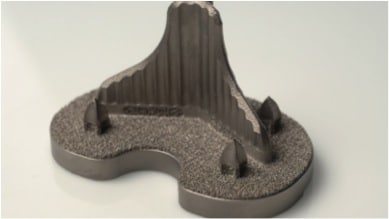Knee replacement surgery is a very common procedure for patients whose arthritis makes it difficult to perform everyday activities. During a knee replacement procedure, the damaged portions of the knee joint are removed and replaced with prosthetic components.
Traditionally, the prosthetics were held in place with bone cement. However, advances in implant technology have led to knee implants that do not need to be cemented into place. Instead, the textured surface of the implant encourages bone growth, so the implant is rigidly fixed to the bone. Both cemented and cementless knee implants are currently used for knee replacements, depending on the needs of the patient.
Cemented Implants

Cemented implants are fixed into place with quick-drying bone cement that bonds the patient’s natural bone with the prosthetic. The majority of knee implants are cemented implants.
Benefits of Cemented Implants
Cemented knee implants have been used for years, so we know that they can be effective in the long term. On average, a cemented implant will last 10 to 20 years or more before it needs to be replaced. The cement dries very quickly, so the implant is securely in place when the surgery is complete.
Cemented implants may be a better option for patients who have poor-quality bone due to conditions like osteoporosis; for these patients, bone growth may not be sufficient enough to hold the implant in place. Cemented implants are often recommended for patients who are older, overweight, and less active, as well.
Potential Problems with Cemented Implants
Over time, the bone cement that holds the implants in place can break down due to stress on the joint. Although it is uncommon for metal prosthetics to break, they can come loose from the bone if the cement begins to break down. If the implant loosens, a revision procedure may be needed. Recent research has highlighted that cemented knee replacements in younger patients may not last as long as those in older patients, simply due to the increased activity and demand they place on the implants and cement which may lead to premature loosening.
As the bone cement breaks down, it can also leave debris behind, which can irritate the tissues surrounding the joint. This can trigger an inflammatory response within the body as it tries to remove the debris. Eventually, it can lead to a condition called osteolysis, in which the body begins to remove small bits of bone around the implant as well. Osteolysis weakens the bone, causing further loosening of the knee implant.
Cementless Implants
Cementless knee implants, also known as press-fit knee implants, have a rough, porous surface that encourages new bone growth. The new bone grows into the spaces in the implant, holding it in place without the need for cement. The bones within the knee are shaped with special tools so that they fit snugly with the implant. In some cases, screws or pegs may be used to hold the prosthetics in place while the bone grows. Currently, cementless implants are only available for total knee replacements.
See Info for Cementless Fixation for Knee Replacement in Younger Patients →
Benefits of Cementless Implants
Because cementless implants use the patient’s natural bone to hold the implants in place, it is thought that they will last longer and form a more permanent bond with the patient’s bones than cemented implants.
Because cement fixation is not needed for these types of implants, patients don’t have to worry about potential complications from cement breakdown. Furthermore, studies have shown that the short-term results are comparable to that of cemented implants.
Potential Problems with Cementless Implants
Cementless implants are relatively new when compared to cemented implants, so we don’t have as much evidence to support long-term effectiveness of these implants. Knee replacements using a cementless implant may also require a longer healing time, because it can take time for new bone growth that is sufficient enough to hold the implant in place.
Cementless implants are not suitable for patients who have poor bone quality due to a condition like osteoporosis; strong, healthy bone is needed to hold the knee implants in place. Also, because the knees take on quite a bit of stress from daily activity, microscopic debris can be created from wear on the implant. As with debris from bone cement, this can trigger an inflammatory response that leads to osteolysis.
Which Type of Implant is Right For You?
Dr. Meneghini specializes in both cemented and cementless knee replacements. A thorough examination and medical history is necessary to determine which type of knee replacement implant is right for you. If you would like to learn more about knee replacement options with Dr. Meneghini, or would like to schedule an appointment for an evaluation, please call our office at (317) 620-0232.

Specialties
- Partial Knee Replacement
- Total Knee Replacement
- Cemented vs. Cementless Knee Replacement
- Joint Pain
- Hip Replacement Surgery
- Outpatient Hip and Knee Replacement Surgery

“Nice work on the knee, Doc! 60 years old and slalom skiing – didn’t hurt it getting up or cutting! It was fun!”
– Lloyd L.
Cementless Knee Replacement